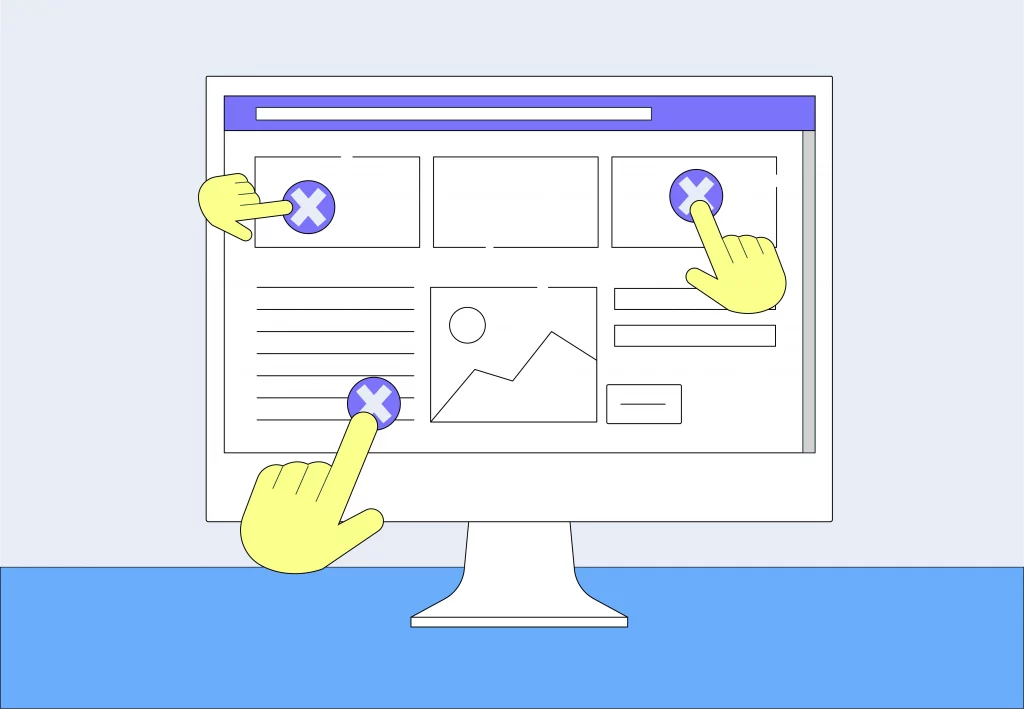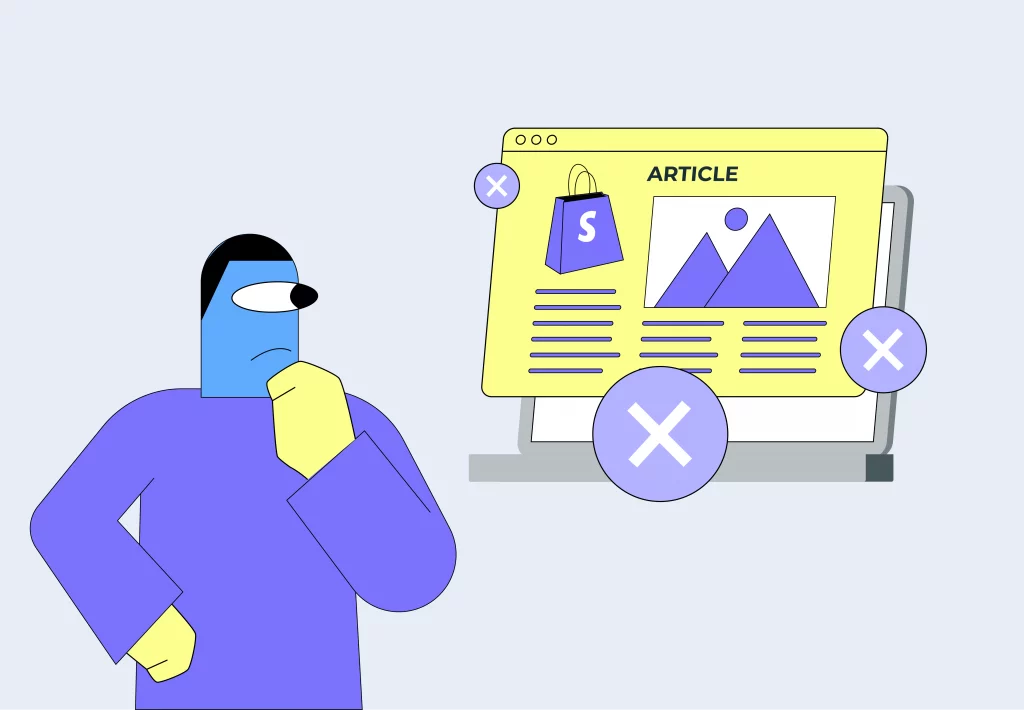Incorporating search engine optimization (SEO) into your marketing strategy is crucial if you want to rank high in search engine results pages (SERPs). Shopify, in particular, incorporates numerous SEO elements that are unique to this all-inclusive online selling platform.
Throughout this article, we’ll present some of the most impactful SEO issues you can encounter on Shopify and teach you how to manage them. From duplicate content and crawling errors to collection page issues—we will discuss some practical tips to help you deal with each problem you may encounter.
The Most Impactful Shopify SEO Issues
They say that the first step in solving any problem is recognizing there is one. Although Shopify offers an abundance of benefits for online stores, there are also numerous technical flaws and imperfections that can lead to various Shopify SEO issues. Such issues can damage your organic traffic and prove disastrous for your business. That’s why you should pay attention to them.
Want to learn more about how to improve SEO on Shopify? Here are five of the most common Shopify SEO issues and how to address them:
Faceted navigation
One of the first Shopify SEO issues you might encounter is related to the faceted navigation system. This system, in most cases, is located on the sidebars of your Shopify store’s site and allows visitors to narrow down their product search results by applying filters. For example, if visitors want to search for pink area rugs only, they click multiple filters based on that faceted classification of items.
In addition to helping visitors throughout the searching process, facets, as indexed categories, act as an extension of your site’s main categories. So, all in all, they are extremely helpful and important for ensuring a great user experience. However, in some cases, especially when they are not checked and managed regularly, your Shopify site can end up having duplicate content and low-value URLs for millions of pages within your online store.
Think of it this way, each time a visitor uses faceted navigation to guide them, the filters create new indexable URLs. At some point, the search engine’s crawl bots will begin to ignore your site and typically remove the duplicate pages from their search index. They do this to prevent users from using such content to gain an advantage in ranking. Thus, it will create a new problem for your store’s visibility and organic traffic regardless of the fact you did not intentionally create so many duplicate pages.
In order to help search engines differentiate between the canonical URL and the many non-canonical ones created each time a filter is used, you should modify the tags used with each page. Generally, Shopify automatically renders the product pages with either of these two tags:
- /products/ – for canonical URL paths
- /collections/.*/products/ – for non-canonical URL paths
So this means that all non-canonical tags include a canonical tag in them associated with the product page. Regularly perform SEO audits to ensure your non-canonical URLs have canonical tags in them. Through canonical tags, you can guide search engines to differentiate between duplicate and canonical content, thus, making it clear that a group of duplicate pages has a preferred version.
Access your Shopify’s “collection-template.liquid” file. Then, find all the lines with {{ product.url | within: collection }} and change any code that is written as:
<a href=”{{ product.url | within: collection }}” class=”product-card”>
to:
<a href=”{{ product.url }}” class=”product-card”>
This way, you ensure that the canonical product URLs are visible from any collections page and show up in the internal links across your Shopify site, regardless of what collections they can be found in.
On-page SEO issues

Another SEO element that is crucial to ensure ease of navigation, as well as crawlability, is on-page optimization. Your Shopify’s on-page SEO aims to make your shop and content as easy to understand and navigate as possible.
However, lacking or incomplete basic SEO elements like titles, meta descriptions, headings, and subheadings can negatively impact the search engine’s understanding of your page’s content hierarchy, leading to decreased relevancy, rankings, and traffic for keywords and overall content.
The first step to fix your on-page SEO is to identify the pages that are not correctly organized with headings and subheadings. There are several tools, such as SEO Minion or Ahrefs, that can help you with this process. Once you have identified which pages are missing titles, headings, subheadings, or have some other issue with on-page elements, the next step is fixing them.
For example, if one of the headers needs to be a subheader, you need to access the template for that specific page. Find the subheader tag it currently contains, and you will most likely find something resembling the tag:
<h1 class = “product-name”>
<a href=”{{product.url}}” tabindex=”0”>{{product.title}}</a>
</h1>
Then, you would simply have to edit the h1 so that it is an h2, and you will end up with the correct tag:
<h2 class = “product-name”>
<a href=”{{product.url}}” tabindex=”0”>{{product.title}}</a>
</h2>
Blog issues in Shopify

Blogging is a crucial part of most eCommerce digital marketing strategies. However, if you are already using WordPress or some other platform for your blogs, chances are they cannot be incorporated into your Shopify site. Therefore, featuring products from your store on another blog or featuring the blog on your product pages is not a seamless process.
The good news is that you can fix such a problem by simply transporting your content to the blog section of your Shopify account. The platform has embedded features that aim to provide a quick and easy way to post your content, such as tools to insert images and videos, automatic SEO for titles and descriptions, the ability to schedule your posts, space for comments, tags, and much more. In short, Shopify offers all the functionality you need to continue blogging.
Another area of Shopify blogging that might lead to issues is the template and themes chosen. Generally, the platform has ready-made templates and themes that users can choose from. However, in some cases, errors can occur when you purchase and apply these elements to your blog. You might have to deal with URLs that redirect to links unrelated to your store or products or an overall decrease in loading speed.
In such instances, it is best to either reconsider the template, theme, and other extensions added or make changes to the code. For example, you can deactivate the redirected links by replacing the JavaScript code of your Shopify theme. To do so, replace the code “window.location.href =” with the line “window.parent.location.href =”, or, if possible, disable it through the theme editor.
URL structure
Another area Shopify users encounter issues with is the restricted URL structure of the platform. Some business owners might not even consider this a problem. However, if you like to optimize all areas of your website, then being unable to customize your URLs can be a problem.
Generally, every page created through your Shopify account will have a folder that cannot be changed. Furthermore, all default pages created through the platform are done via subdirectory, making all URLs lengthier. Instead of the typical hierarchy of structure that most eCommerce stores have where the links look like this: https://your-domain/category/sub-category/product, with Shopify’s hierarchical structure, you are usually stuck with longer URLs that look something like this: https://your-domain.com/collections/collection-name/products/product-name
Similarly, the URL structure of blog posts has a structure that follows the same rules:
So, unlike other websites where the issue could quickly be solved by creating categories and subcategories that allow you to organize URLs in a better way, Shopify does not offer such a feature. However, you can still organize your products using other methods.
To begin, you should ensure you get the best exposure through relevant keywords in the parts that you can customize, such as the URL slug. Next, you can use breadcrumbs with schema markup. This way, you help the search engines understand what categories and subcategories are included in your store. You could also create an interlink by using relevant keywords as anchor texts or add megamenus to the homepage to have more control over the way products are categorized in your Shopify store.
Product available under a different URL
If you have many items on your Shopify store, chances are that you will have to deal with some broken links from time to time. To avoid this problem, you will need to redirect the URL of the product in order to ensure availability for the visitors. Through these URL redirects, you guide your visitors from one URL to a different one under your domain where the product they are interested in is available. You can redirect a single URL or numerous pages at once from one domain to another.
To redirect your Shopify content, you need to follow these steps:
- Go to Shopify admin and access the Online Store
- Click on Navigation
- Click on URL Redirects
- Click on Create URL Redirect
- Enter the old URL in the redirect form under “Redirect from”
- Enter the new URL in the redirect form under “Redirect to”
- Save the redirect
However, even after following the above-mentioned steps, in some circumstances, errors can occur. The reason for such errors is because, typically, the system prioritizes existing pages over processing a redirect. Therefore, for a redirected URL to work, you will need to delete the page on the original URL. But, when dealing with faceted navigation and URLs that once existed but have since been removed, the requests are likely to result in errors. In short, you must ensure that the old path no longer exists for the redirect to be processed.
The Bottom Line
To conclude, Shopify is one of the biggest eCommerce platforms worldwide. However, just like with any website, you’ll encounter some challenges and issues along the way that you must learn to manage, specifically ones related to Shopify SEO. These problems may be holding back your site from ranking in Google and other search engines.
While you and your users utilize some features of the store, you end up creating duplicate content that leads to various problems that can damage your visibility, CTR, and conversion. That is why it is best to regularly review your Shopify store and make updates when needed in order to ensure your store is competitive in the search results.
Depending on what issue you are dealing with, there are various ways to manage them. You can follow the tips provided throughout this article and install extensions, use the method of canonicalization, make changes to the code, redirect the URL, and many more steps to ensure your Shopify store and blog are working properly. Or, you could work with an SEO expert agency that can address and solve any similar issues your store faces.